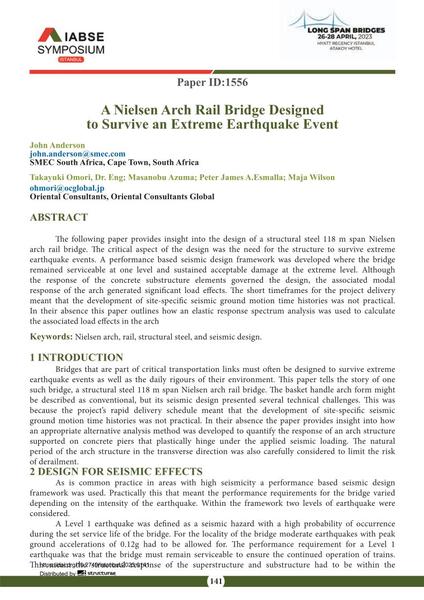A Nielsen Arch Rail Bridge Designed to Survive an Extreme Earthquake Event

|
|
|||||||||||
Détails bibliographiques
| Auteur(s): |
John Anderson
(SMEC South Africa, Cape Town, South Africa)
Takayuki Omori (Oriental Consultants, Oriental Consultants Global) Masanobu Azuma (Oriental Consultants, Oriental Consultants Global) Peter James A. Esmalla (Oriental Consultants, Oriental Consultants Global) Maja Wilson (Oriental Consultants, Oriental Consultants Global) |
||||
|---|---|---|---|---|---|
| Médium: | papier de conférence | ||||
| Langue(s): | anglais | ||||
| Conférence: | IABSE Symposium: Long Span Bridges, Istanbul, Turkey, 26-28 April 2023 | ||||
| Publié dans: | IABSE Symposium Istanbul 2023 | ||||
|
|||||
| Page(s): | 141-149 | ||||
| Nombre total de pages (du PDF): | 9 | ||||
| Année: | 2023 | ||||
| DOI: | 10.2749/istanbul.2023.0141 | ||||
| Abstrait: |
The following paper provides insight into the design of a structural steel 118 m span Nielsen arch rail bridge. The critical aspect of the design was the need for the structure to survive extreme earthquake events. A performance based seismic design framework was developed where the bridge remained serviceable at one level and sustained acceptable damage at the extreme level. Although the response of the concrete substructure elements governed the design, the associated modal response of the arch generated significant load effects. The short timeframes for the project delivery meant that the development of site-specific seismic ground motion time histories was not practical. In their absence this paper outlines how an elastic response spectrum analysis was used to calculate the associated load effects in the arch |
||||


